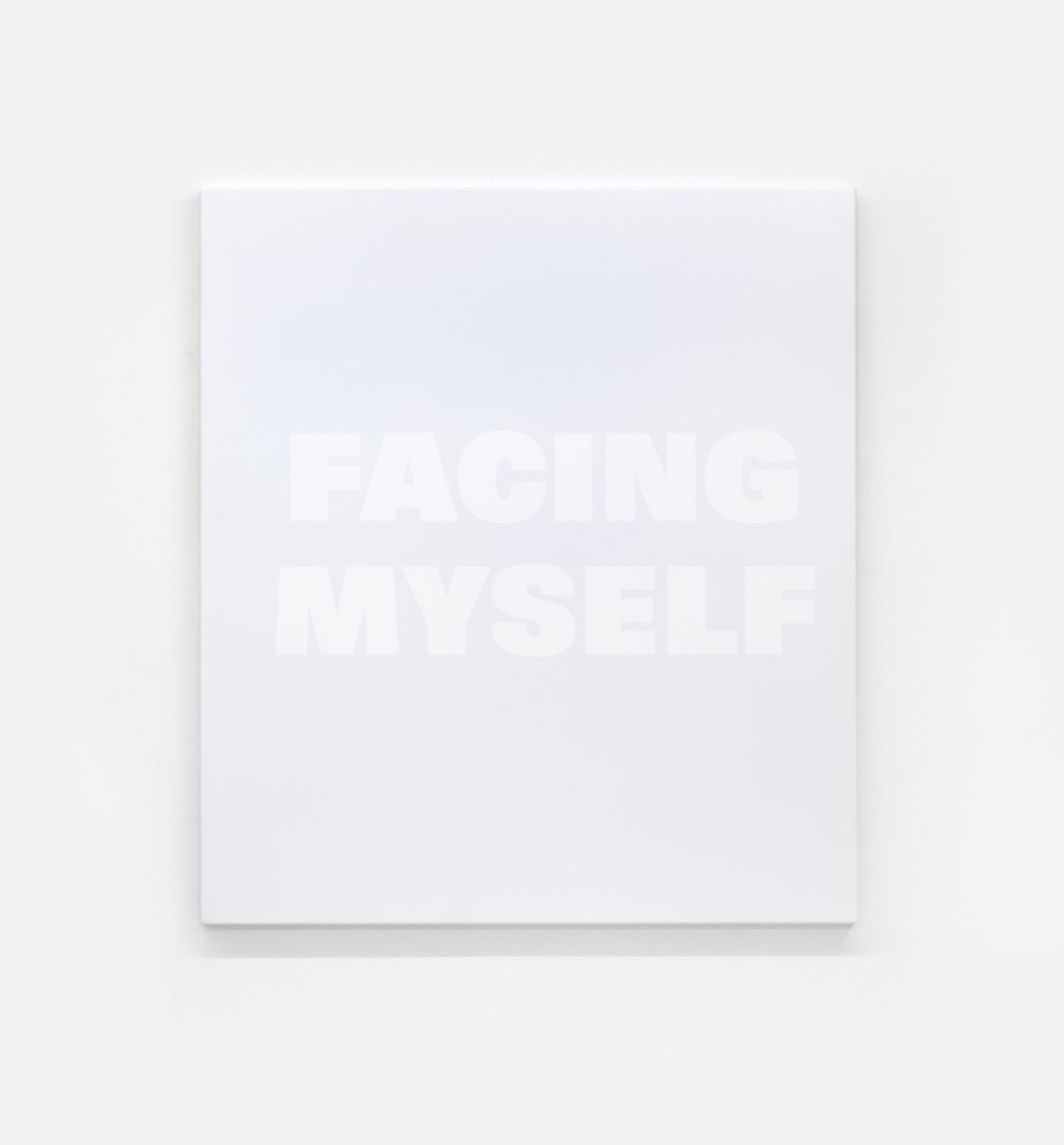Rémy Zaugg
I, myself.
27 Apr - 01 Jun 2019

Rémy Zaugg
I, myself., 2002/2003, detai
18 paintings, aluminum, sprayed varnish, silk-screen printing, clear varnish, various dimensions
I, myself., 2002/2003, detai
18 paintings, aluminum, sprayed varnish, silk-screen printing, clear varnish, various dimensions
RÉMY ZAUGG
I, myself.
27 April - 1 June 2019
For the first time since it was first exhibited 15 years ago, Rémy Zaugg’s comprehensive self-portrait “I, myself.” (2002/03, comprising 18 pale grey text-paintings in different sizes, will be on view again. Swiss artist Rémy Zaugg (1943–2005) is renowned for his works that merge the domains of image and language, engaging the viewer in a complex discussion on perception as well the relevance of modernist abstract painting. Zaugg’s paintings address not only the act of seeing but cognition as a holistic process of the entire perceptual apparatus. Starting with his work “Esquisses perceptives d’un tableau” (1963–68), his annotations to a painting by Cézanne, the artist has systematically developed this relationship between artwork, viewer and context into the central topic of his multidisciplinary oeuvre.
“I, myself.” derives from a meticulous production process. Industrially fabricated, the paintings’ smooth surfaces show no trace of their making, nor those of human touch, and thus emphasise instead the relation of colour and text. Perfect and without history, they are devoid of any associations to painting. The number of words printed onto the aluminium panels in white automotive paint determines the individual size of each painting. The texts are short, fragmentary, partly poetic, but never simple. The white lettering hardly stands out against the light-grey background. Thus overstimulating our senses, the contours start to vibrate so that reading the text irritates one’s eyes. In addition, the minimally different grey hues of the various paintings complicate the act of seeing. Full of contradictions and paradoxes these paintings force us into a state of radical awareness of our own perceptual process and its limitations.
Cézanne is also a reference point for “I, myself.” Zaugg draws on the long history of the self-portrait from Dürer to Lassnig, where the self-portrait became a tool for self-examination and self-confession, making apparent the artist’s grappling both with the self and the work. At the same time, these works transcend the personal and disclose the artist’s relationship to the world. Unlike Cézanne, who set up a mirror to confront his own self, Zaugg turns his paintings into mirrors and entrusts the viewer with the existential question “Who am I?”
The themes of self-reflection and the related question of the basic principles determining our gaze appear today to be more relevant than ever. “I, myself.” offers neither certainties nor easy visual pleasure. “The artist makes an effort to wipe the smile off the faces of those who are knowledgeable, are in the know, and who know what they know,” Zaugg wrote in 1986 on the responsibility of the artist. The world is different to each of us, he insists, and our perception is unique.
I, myself.
27 April - 1 June 2019
For the first time since it was first exhibited 15 years ago, Rémy Zaugg’s comprehensive self-portrait “I, myself.” (2002/03, comprising 18 pale grey text-paintings in different sizes, will be on view again. Swiss artist Rémy Zaugg (1943–2005) is renowned for his works that merge the domains of image and language, engaging the viewer in a complex discussion on perception as well the relevance of modernist abstract painting. Zaugg’s paintings address not only the act of seeing but cognition as a holistic process of the entire perceptual apparatus. Starting with his work “Esquisses perceptives d’un tableau” (1963–68), his annotations to a painting by Cézanne, the artist has systematically developed this relationship between artwork, viewer and context into the central topic of his multidisciplinary oeuvre.
“I, myself.” derives from a meticulous production process. Industrially fabricated, the paintings’ smooth surfaces show no trace of their making, nor those of human touch, and thus emphasise instead the relation of colour and text. Perfect and without history, they are devoid of any associations to painting. The number of words printed onto the aluminium panels in white automotive paint determines the individual size of each painting. The texts are short, fragmentary, partly poetic, but never simple. The white lettering hardly stands out against the light-grey background. Thus overstimulating our senses, the contours start to vibrate so that reading the text irritates one’s eyes. In addition, the minimally different grey hues of the various paintings complicate the act of seeing. Full of contradictions and paradoxes these paintings force us into a state of radical awareness of our own perceptual process and its limitations.
Cézanne is also a reference point for “I, myself.” Zaugg draws on the long history of the self-portrait from Dürer to Lassnig, where the self-portrait became a tool for self-examination and self-confession, making apparent the artist’s grappling both with the self and the work. At the same time, these works transcend the personal and disclose the artist’s relationship to the world. Unlike Cézanne, who set up a mirror to confront his own self, Zaugg turns his paintings into mirrors and entrusts the viewer with the existential question “Who am I?”
The themes of self-reflection and the related question of the basic principles determining our gaze appear today to be more relevant than ever. “I, myself.” offers neither certainties nor easy visual pleasure. “The artist makes an effort to wipe the smile off the faces of those who are knowledgeable, are in the know, and who know what they know,” Zaugg wrote in 1986 on the responsibility of the artist. The world is different to each of us, he insists, and our perception is unique.
